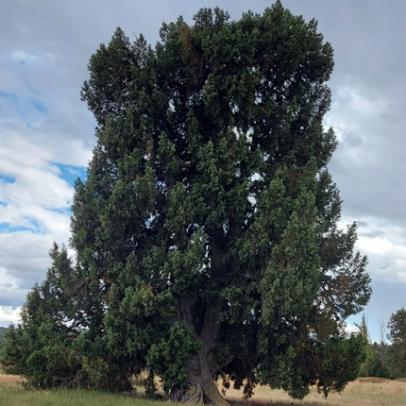This is known as the Dehesa de Vadorrey juniper forest, in allusion to a medieval village that has completely disappeared except for the ruins of its defensive tower next to the Douro. However, we know that the village existed because it is mentioned in documents, including the Cantar de Mío Cid. The legend says that the inhabitants died because they were poisoned by the water from a spring, and their bells are in the church in Aguilera.
Spanish juniper (Juniperus thurifera) is regarded by botanists as a living fossil that has survived since the Tertiary Era and whose ability to adapt enables it to thrive in the most extreme environments, where other natural species fail to grow. Its survival strategy consists of a very powerful system of roots, very slow growth, and scaly leaves covered by a cuticle that protects them from extreme temperatures and minimises evaporation. Since they colonise the most inhospitable places, they are usually quite small. However, the exceptional environmental conditions in the surroundings of Morales (humidity, soil and climate) mean that the trees are over 15 metres tall, rivalling the black poplars on the riverbank in their height.
- Access by car: along an earth track suitable for all kinds of vehicles (it may be muddy in wet weather). From Morales, take the road towards Recuerda, after 20 metres, turn right along an earth track (the track to Molino), which is signposted with the arrow of the Way of El Cid trekking route. The track which is firm and suitable for all vehicles goes down to the bank of the River Douro, where the juniper trees are located.
- Access for people with limited mobility: there are no infrastructures adapted for people with limited mobility, but the site can be reached by vehicle along the earth track.
- Legal protection: the largest specimen (La Pica juniper tree) is listed in a catalogue of outstanding trees in the region of Castilla y León. The river banks form part of the Site of Community Importance ES4170083 (Banks of Douro and tributaries).
- Seasonality: any time of the year as the Spanish juniper is a species with permanent leaves all year. Recommendations, what to see and do: a landmark on the Way of El Cid is next to the junipers: the passage of Vadorrey, an Islamic tower of which only a few ruins remain today. It is on the route that we have followed, about 500m before reaching the junipers, next to a Way of El Cid information board.
Rev.: PAB 05.05.23


